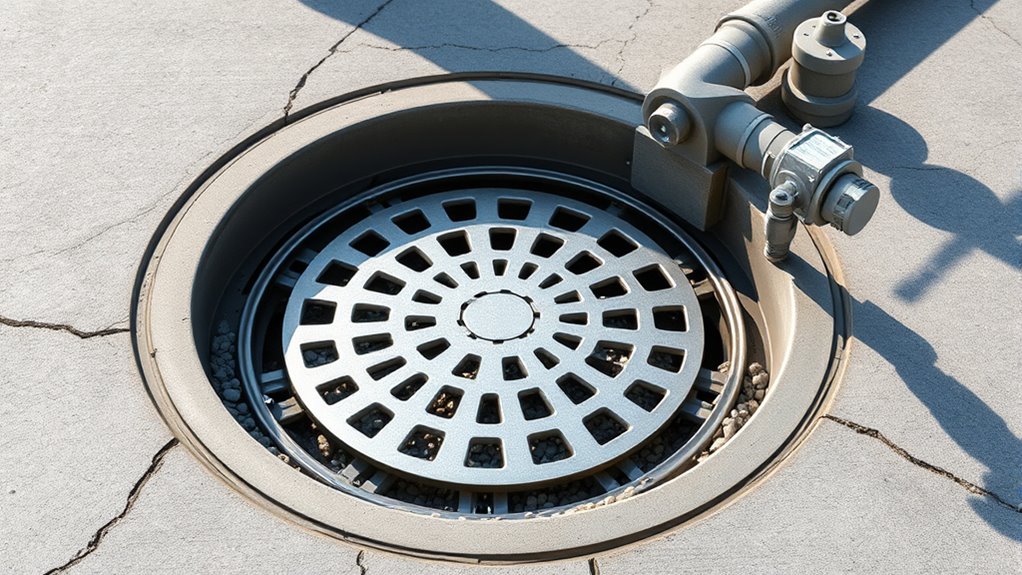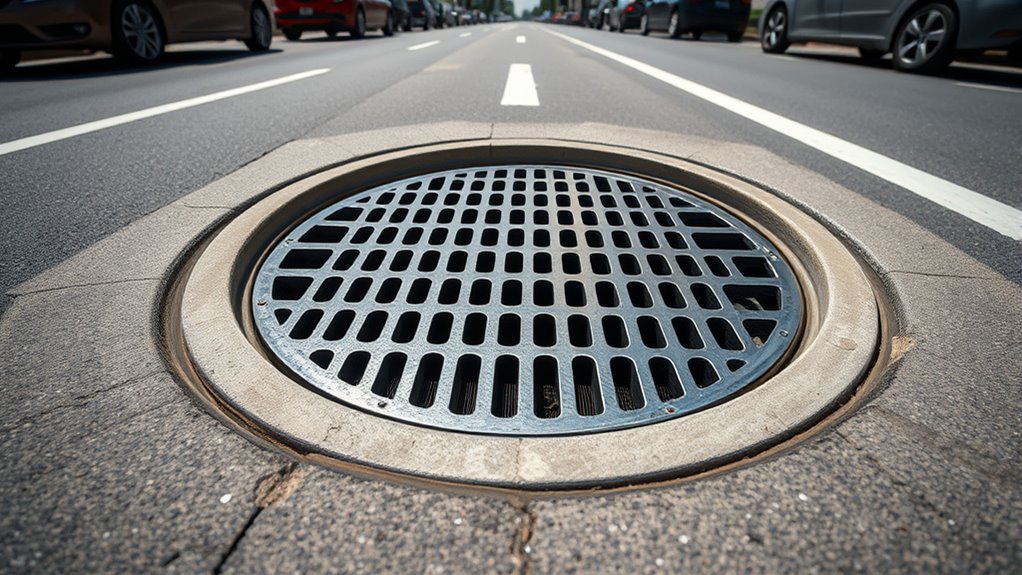When designing a catch basin, you need to size it based on the expected rainfall intensity and runoff volume in your area. Consider flow velocities to prevent erosion and bypass, and make sure the inlet and outlet are adequately designed to handle peak flow without upstream flooding. Proper sediment traps and control features are also essential for long-term efficiency. If you want to guarantee your basin effectively manages stormwater, keep exploring these important design considerations.
Key Takeaways
- Proper basin sizing balances expected rainfall intensity, runoff volume, and surface type to prevent overflow or unnecessary costs.
- Inlet and outlet design should accommodate peak flow rates, preventing splashing, bypass, or upstream flooding.
- Flow velocity considerations are essential to avoid erosion and ensure sediment settles effectively within the basin.
- Sediment control features like sumps and traps reduce clogging, facilitating maintenance and pollutant removal.
- Regular maintenance and sediment removal are critical to maintain drainage efficiency and system longevity.

Have you ever wondered how stormwater drains efficiently from streets and parking lots? It’s all about the design of catch basins, which play a vital role in stormwater management. Proper sizing and flow considerations guarantee that these systems work effectively, preventing flooding and property damage. When designing a catch basin, you need to consider both the volume of water that will flow into it during heavy storms and the importance of sediment control. If the basin is too small, it will overflow, leading to localized flooding and potential erosion. Conversely, an oversized basin may be unnecessarily costly and complicated to install, so striking the right balance is key.
To start, understanding the expected rainfall intensity in your area helps determine the flow rate that the catch basin must handle. You can use historical rainfall data to estimate peak runoff, which informs the sizing process. The flow rate isn’t just about water volume; it also involves the velocity at which water enters the basin. If flow velocity is too high, it can cause erosion within the basin and lead to sediment being carried along with the stormwater. Sediment control becomes vital here because particles like dirt, debris, and other pollutants can clog the drainage system, reducing its capacity and increasing maintenance needs. Incorporating sediment filters or traps within the catch basin helps capture these particles before they enter downstream water bodies.
Flow considerations also involve the inlet design. Properly sized inlets prevent water from splashing or bypassing the basin during intense storms. You want to guarantee that the inlet opening can accommodate the expected flow without causing upstream flooding. The outlet structure, often a grate or pipe, must be designed to release water at a controlled rate to prevent downstream erosion. When sizing these components, you should account for the stormwater runoff coefficient, which varies based on surface types and land use. Impervious surfaces like asphalt and concrete generate more runoff, requiring larger or more efficient catch basins. Additionally, understanding how home furnishings can impact drainage systems is useful, as certain fixtures or installations near stormwater infrastructure may influence flow or sediment accumulation.
Additionally, you need to factor in sediment control features. Installing sediment sumps or traps within the basin allows sediments to settle out, reducing the amount of debris that reaches the storm sewer system. Regular maintenance is necessary to remove accumulated sediments and debris, ensuring the system continues to function effectively. By carefully considering stormwater management principles and incorporating sediment control measures, you can design catch basins that are both efficient and durable. Proper sizing and flow considerations ultimately help safeguard properties, protect the environment, and guarantee smooth drainage during the heaviest storms.
Frequently Asked Questions
What Materials Are Best for Durable Catch Basin Construction?
For durable catch basin construction, you should choose materials with high durability and construction longevity. Concrete is a top choice because it withstands heavy loads and harsh weather. PVC or HDPE plastics are also excellent, offering resistance to corrosion and chemicals. These materials guarantee your catch basin remains sturdy over time, reducing maintenance needs and preventing failures. Selecting the right material depends on site conditions and expected flow, but durability should always be your priority.
How Often Should Catch Basins Be Inspected and Maintained?
Ironically, you might think catch basins are self-cleaning, but you’ll want to inspect them regularly. You should schedule inspections at least twice a year, especially after heavy storms, to guarantee proper flow and prevent blockages. Regular maintenance, including removing debris and checking for damage, is essential for peak performance. Staying diligent with your inspection frequency and maintenance schedule keeps your catch basins functioning efficiently, avoiding costly repairs down the line.
Can Catch Basins Handle Heavy Industrial Runoff?
Yes, catch basins can handle heavy industrial runoff if they’re properly designed for heavy flow management. You need to guarantee they have adequate sizing and flow capacity to prevent flooding or clogging during peak industrial runoff events. Regular inspections and maintenance are essential to keep the catch basins functioning effectively, especially in areas prone to heavy flow. Properly designed and maintained catch basins will efficiently manage industrial runoff and protect your infrastructure.
What Are the Environmental Impacts of Catch Basin Design?
Did you know that poorly designed catch basins can contribute to 80% of urban stormwater pollution? Your catch basin’s design impacts the environment by potentially reducing stormwater pollution and habitat disruption. Effective sizing and flow consideration minimize contaminants entering water bodies, helping protect ecosystems. By ensuring proper design, you help prevent habitat disruption and maintain cleaner waterways, ultimately fostering healthier urban and natural environments.
How Do Climate Changes Affect Catch Basin Sizing Requirements?
Climate changes require you to adapt catch basin sizing for increased storm variability. You need larger basins or enhanced capacity to handle more intense rainfall events, preventing flooding and water damage. By incorporating climate adaptation strategies, you guarantee your catch basins efficiently manage unpredictable storm patterns, safeguarding infrastructure and environment. Adjusting sizing based on projected climate impacts keeps your stormwater management resilient and effective amid changing weather conditions.
Conclusion
As you finalize your catch basin design, remember it’s the silent guardian of your drainage system, quietly absorbing storms like a sponge in a storm’s embrace. By carefully sizing and considering flow, you craft a reservoir that dances gracefully with nature’s unpredictable rhythm. Think of it as the heart of your landscape’s drainage, pulsating steadily beneath the surface, ensuring your project stands resilient against the deluge. A well-designed catch basin is your fortress in the flood’s relentless tide.










